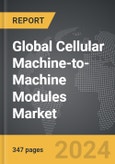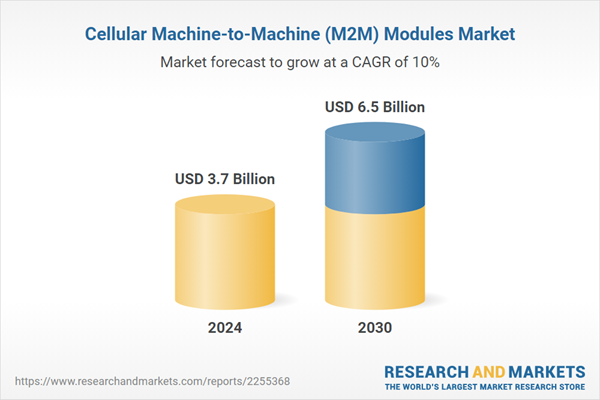Global Cellular Machine-to-Machine (M2M) Modules Market - Key Trends & Drivers Summarized
What Are Cellular Machine-to-Machine (M2M) Modules and How Do They Transform Industries?
Cellular Machine-to-Machine (M2M) modules facilitate automatic and wireless communication between machines, devices, and control systems across cellular networks. These devices are foundational to the Internet of Things (IoT), connecting everything from vehicles and factory machinery to home appliances and street lights, enabling them to collect and exchange data. M2M modules integrate seamlessly into various objects, empowering industries to automate processes and gather extensive insights into operational efficiency and resource management. Such capabilities are crucial for advancing sectors like manufacturing, healthcare, and urban development, where efficiency and rapid response times are essential. By minimizing human intervention, M2M modules enhance reliability, improve safety, and reduce operational costs, which are key to driving the next wave of industrial automation and smart city applications.How Are Advancements in Cellular Technology Enhancing M2M Modules?
The evolution of cellular technologies, especially with the advent of 5G, has significantly impacted the functionality of M2M modules. These advancements have introduced higher bandwidths, extremely low latency, and the ability to connect more devices per unit area, which are critical features for the expanding scope of IoT deployments. M2M modules equipped with 5G technology offer enhanced capabilities for real-time data transmission, supporting complex applications such as autonomous driving, remote medical surgeries, and advanced industrial automation. Furthermore, ongoing enhancements in energy efficiency and module miniaturization allow for their deployment in a wider range of environments, reducing barriers to implementation and enabling more industries to leverage the benefits of M2M connectivity.What Trends Are Currently Influencing the M2M Module Market?
The M2M module market is influenced by several significant trends that underscore the evolving needs of a connected world. The drive towards smart cities is a major factor, with municipalities around the globe deploying IoT devices using M2M modules to optimize everything from traffic management to waste control. Similarly, in the industrial sector, the push for Industry 4.0 technologies is accelerating the adoption of M2M solutions to enhance connectivity and automation on the manufacturing floor. Environmental monitoring and management have also benefited from M2M advancements, enabling more precise and frequent data collection for climate and agricultural applications. These trends not only drive the demand for advanced M2M modules but also shape the strategic focus of companies operating in the IoT and telecommunications space.What Are the Factors Driving Growth in the Cellular M2M Modules Market?
The growth in the cellular M2M modules market is driven by several factors, crucial for addressing both current and emerging communication needs. Technological advancements that improve connectivity and data throughput capabilities are essential as they facilitate more complex and demanding applications across various sectors. Economic development in emerging markets is contributing significantly to market expansion as new industries adopt M2M technologies to improve competitiveness and operational efficiency. Furthermore, the increasing emphasis on sustainability and regulatory compliance encourages industries to deploy M2M solutions to monitor and reduce their environmental impact. Consumer behavior trends towards interconnected and smart technology solutions also play a vital role in propelling the demand for M2M modules, mirroring the broader shift towards digital integration in personal and professional settings. Together, these factors ensure a dynamic and robust growth trajectory for the cellular M2M modules market, highlighting its indispensable role in the global push towards greater connectivity and intelligence.Report Scope
The report analyzes the Cellular Machine-to-Machine (M2M) Modules market, presented in terms of market value (USD). The analysis covers the key segments and geographic regions outlined below.- Segments: Application (Fleet Management, Security, Remote Monitoring & Control, Electronic Payment Systems, Automotive, Other Applications).
- Geographic Regions/Countries: World; USA; Canada; Japan; China; Europe; France; Germany; Italy; UK; Spain; Russia; Rest of Europe; Asia-Pacific; Australia; India; South Korea; Rest of Asia-Pacific; Latin America; Argentina; Brazil; Mexico; Rest of Latin America; Middle East; Iran; Israel; Saudi Arabia; UAE; Rest of Middle East; Africa.
Key Insights:
- Market Growth: Understand the significant growth trajectory of the Fleet Management Application segment, which is expected to reach US$2 Billion by 2030 with a CAGR of 10.3%. The Security Application segment is also set to grow at 9.4% CAGR over the analysis period.
- Regional Analysis: Gain insights into the U.S. market, valued at $822 Million in 2024, and China, forecasted to grow at an impressive 12.8% CAGR to reach $747.4 Million by 2030. Discover growth trends in other key regions, including Japan, Canada, Germany, and the Asia-Pacific.
Why You Should Buy This Report:
- Detailed Market Analysis: Access a thorough analysis of the Global Cellular Machine-to-Machine (M2M) Modules Market, covering all major geographic regions and market segments.
- Competitive Insights: Get an overview of the competitive landscape, including the market presence of major players across different geographies.
- Future Trends and Drivers: Understand the key trends and drivers shaping the future of the Global Cellular Machine-to-Machine (M2M) Modules Market.
- Actionable Insights: Benefit from actionable insights that can help you identify new revenue opportunities and make strategic business decisions.
Key Questions Answered:
- How is the Global Cellular Machine-to-Machine (M2M) Modules Market expected to evolve by 2030?
- What are the main drivers and restraints affecting the market?
- Which market segments will grow the most over the forecast period?
- How will market shares for different regions and segments change by 2030?
- Who are the leading players in the market, and what are their prospects?
Report Features:
- Comprehensive Market Data: Independent analysis of annual sales and market forecasts in US$ Million from 2024 to 2030.
- In-Depth Regional Analysis: Detailed insights into key markets, including the U.S., China, Japan, Canada, Europe, Asia-Pacific, Latin America, Middle East, and Africa.
- Company Profiles: Coverage of players such as Huawei Technologies Co., Ltd., ZTE Corporation, Kyocera Corporation, Sierra Wireless, Inc., u-blox AG and more.
- Complimentary Updates: Receive free report updates for one year to keep you informed of the latest market developments.
Some of the 25 companies featured in this Cellular Machine-to-Machine (M2M) Modules market report include:
- Huawei Technologies Co., Ltd.
- ZTE Corporation
- Kyocera Corporation
- Sierra Wireless, Inc.
- u-blox AG
- Telit IoT Platforms, LLC
- Aeris Communications, Inc.
- ZTE USA
- Quectel Wireless Solutions Co., Ltd.
- Solexy S.R.L.
This edition integrates the latest global trade and economic shifts into comprehensive market analysis. Key updates include:
- Tariff and Trade Impact: Insights into global tariff negotiations across 180+ countries, with analysis of supply chain turbulence, sourcing disruptions, and geographic realignment. Special focus on 2025 as a pivotal year for trade tensions, including updated perspectives on the Trump-era tariffs.
- Adjusted Forecasts and Analytics: Revised global and regional market forecasts through 2030, incorporating tariff effects, economic uncertainty, and structural changes in globalization. Includes historical analysis from 2015 to 2023.
- Strategic Market Dynamics: Evaluation of revised market prospects, regional outlooks, and key economic indicators such as population and urbanization trends.
- Innovation & Technology Trends: Latest developments in product and process innovation, emerging technologies, and key industry drivers shaping the competitive landscape.
- Competitive Intelligence: Updated global market share estimates for 2025, competitive positioning of major players (Strong/Active/Niche/Trivial), and refined focus on leading global brands and core players.
- Expert Insight & Commentary: Strategic analysis from economists, trade experts, and domain specialists to contextualize market shifts and identify emerging opportunities.
Table of Contents
Companies Mentioned (Partial List)
A selection of companies mentioned in this report includes, but is not limited to:
- Huawei Technologies Co., Ltd.
- ZTE Corporation
- Kyocera Corporation
- Sierra Wireless, Inc.
- u-blox AG
- Telit IoT Platforms, LLC
- Aeris Communications, Inc.
- ZTE USA
- Quectel Wireless Solutions Co., Ltd.
- Solexy S.R.L.
Table Information
| Report Attribute | Details |
|---|---|
| No. of Pages | 347 |
| Published | December 2025 |
| Forecast Period | 2024 - 2030 |
| Estimated Market Value ( USD | $ 3.7 Billion |
| Forecasted Market Value ( USD | $ 6.5 Billion |
| Compound Annual Growth Rate | 10.0% |
| Regions Covered | Global |









